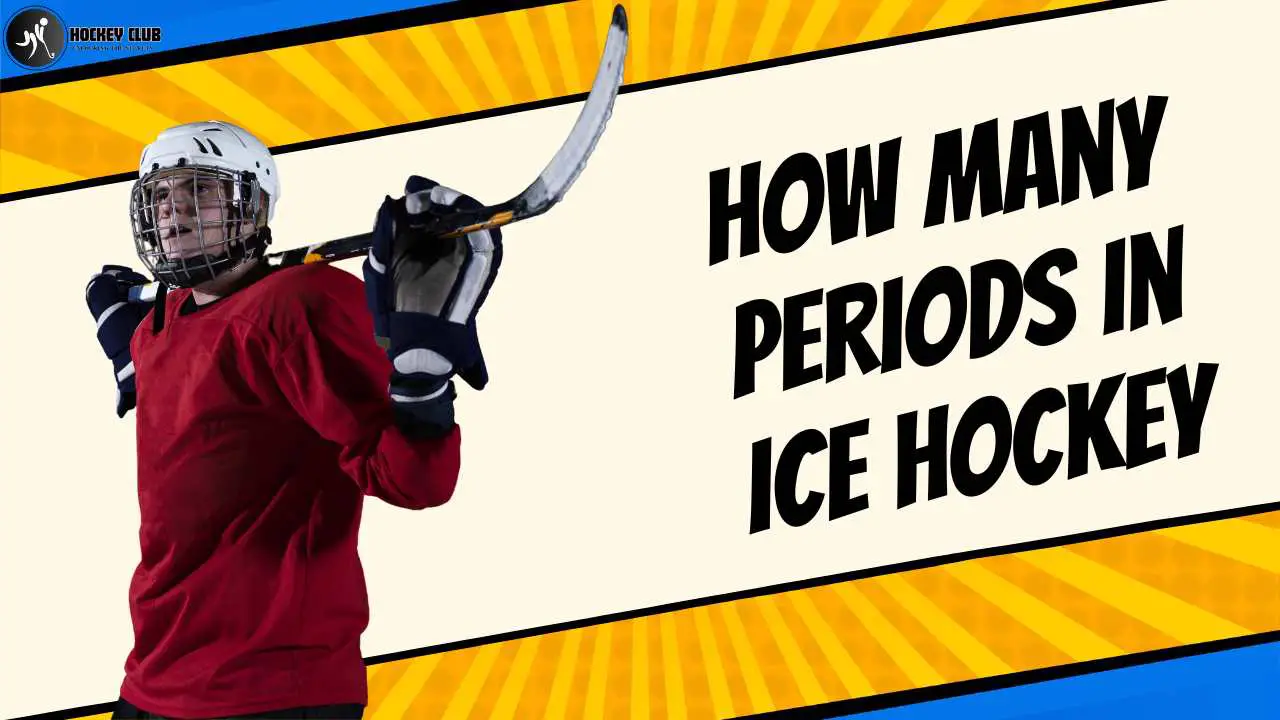Understanding How Many Periods In Ice Hockey!! Explore Now.

Ice hockey, my friend, is a thrilling world of speed, skills, and strategy. Played on a rectangle of pure, shimmering ice with sticks and a puck, the game is an adrenaline-pumping spectacle and a mental challenge. And for those carefully counting the minutes and eagerly waiting for the direct face-off between the goaltender and the attacking team, you should ask an important question: “Just how many periods are there in a game of ice hockey?” Let’s slice through the ice to find the answer.
- In a standard ice hockey game, there are three periods, each consisting of 20 minutes of playtime.
- Between each period, there is a 17-minute intermission. This makes for two rest breaks where players have time to rest, strategise, and replenish energy levels.
- In total, a standard ice hockey game in the NHL typically lasts around two and a half hours, including playtime, intermissions, and potential overtime.
Before we proceed, let’s equip you with some fundamentals. Standard ice hockey games consist of three periods, each lasting 20 minutes. Intervals between these periods allow for both rest and ice resurfacing. But that’s not all there is to know about periods in ice hockey. So, buckle up your skates, and let’s delve deeper into the fascinating world of ice hockey periods.
[ez-toc]
How Many Periods In Ice Hockey
You’re probably familiar with the structure of other sports games, like soccer or basketball, which have halves or quarters. But it’s a completely different ballgame – or should I say puck game – when it comes to ice hockey. I bet you’re wondering just how many periods there are in this bone-chilling sport called ice hockey. Well, sit tight because you’re about to find out.
Picture this: an icy rink where adrenaline-filled players face off, moving swiftly as the wind on a blizzard. The gameplay? Structured into three riveting periods of 20 minutes each. That’s right, ice hockey isn’t divided into two halves or four quarters, but rather, three action-filled periods that proficiently contribute to the enthralling drama of the game.
But that’s not all. The excitement in the air doesn’t dissolve after a period ends because there are two intermissions that last anywhere from 15 to 18 minutes. That’s when the players catch their breath while the spectators catch the jittery anticipation of what comes next.
Ice hockey is unique not only for its play on a frozen surface but also for the specialized gear players use and this distinct game structure. But remember, different leaagues, like the IIHF World Junior Championship, NCAA Hockey, and Minor League Hockey, might have variations in their game structures and overtime rules.
And speaking of overtime, hockey novices might find it surprising that overtime games have the potential to extend the duration of the overall gameplay by hours. NHL playoffs, for instance, have continuous 20-minute 5-on-5 overtime periods that play out until a clear winner is decided.
Going further into the lush complexity of ice hockey, the core gameplay also includes face-offs, power plays, and penalties. Additionally, factors like television broadcasts, whistle stoppages, and power plays have a crucial role in affecting game duration. In fact, understanding this tapestry of elements paints a holistic picture of the duration of ice hockey games.
The next time you watch an ice hockey match, you’ll not only know how many periods the game consists of but also have an expanded perspective on the intricate elements that make up the gripping drama of this icy sport.
The Significance of the Three Periods in Ice Hockey
Periods structure of ice hockey is what sets the sport apart from others, which typically divide their gameplay into halves or quarters. These three, 20-minute periods, separated by two intermissions that generally span 15 to 18 minutes, provide a unique rhythm to the game that’s both thrilling and strategic.
Each period in an ice hockey game contributes its own distinct narrative, characterized by the tantalizing ebb and flow of action on the frozen rink. In the early beginnings, teams size each other up and feel out for their opponents’ strategies. As the contest progresses, energy levels fluctuate, tactics evolve, and the competition intensifies, culminating in a spectacular, often nail-biting, finish.
It’s during these periods that key elements of the game come into play – faceoffs, powerplays, and penalties. Each has its own way of affecting the game’s progression, enhancing the entertainment factor for the spectators and demanding a formidable tactical prowess from the players and coaches alike.
The three periods also have a significant impact on the game’s total length, which generally ranges between 2 to 3 hours. Variations in this duration occur due to factors such as television broadcasts, whistle stoppages, and power plays. It is worth noting that the structure and length might vary slightly among different leagues, but the three-period format remains the underlying staple.
Beyond the standard three periods, there’s the possibility of overtime – a crucible where hockey legends are made. History is replete with memorable overtime moments, especially from revered events like the Stanley Cup Finals and the Olympic Games. Whether it’s seizing the moment with a golden goal or simply outlasting opponents in a grueling battle of attrition, overtime in hockey brings an added layer of excitement and unpredictability.
Whether it’s the NHL, the IIHF World Junior Championship, NCAA Hockey, or Minor League Hockey, each league has its unique nuances within this three-period structure. The ability to adapt to these variations in rules and game structures is pivotal in transcending the levels in the world of ice hockey. Nonetheless, the heart of the game remains consistent – three intense periods of dueling it out on the cold, hard ice, where skill, strategy, and sheer will determine the victors.
What are the rules regarding player substitutions during ice hockey periods?
Player substitution in ice hockey is a key aspect of match strategy and is governed by a set of established rules. One important aspect that ice hockey fans often ask about relates to the penalty box. If a goaltender is pulled from the rink to serve a penalty, it’s up to the team’s manager to appoint a substitute.
Of course, substitutions also play a critical role during penalties. The 1966-67 season witnessed the dawn of a significant rule change, allowing teams to make substitutions on coincidental major penalties. Over the seasons, similar rules have evolved, such as the policy introduced in the 1985-86 season, allowing substitutions in the occasion of co-incidental minor penalties.
Apart from penalty-related policies, there are a few more rules associated with player substitution. For instance, if a player’s helmet comes off during play, they need to leave the ice. This rule helps ensure the safety of the players. However, there is an exception; if a player manages to retrieve their helmet, they are allowed to rejoin the action—But this caveat is only available to seasoned NHL performers with more than 25 games under their belts.
Another substitution rule revolves around the defensive strategies teams employ. Once the puck goes up the ice, no more than three players, including the goaltender, may remain in their defensive zone. This rule ensures an engaging and strategic play and affects how teams manage their substitutes.
Excitingly, even the spectators have a role to play in substitutions. Back in the 1964-65 season, a rule was set down ensuring that each team’s substitute goaltender should be dressed in his regular uniform, excluding leg pads and body protector, during playoff games.
Thus, whether it stems from on-ice incidents or is driven by strategic planning, rules surrounding player substitutions in ice hockey deepen the complexity and excitement of the game. These rules, while serving the basic purpose of maintaining order during matches, also contribute to the dynamics and unpredictability of ice hockey.
What strategies do teams typically use during different periods in ice hockey?
Ice hockey, unlike many other sports, does not split its game time into halves or quarters. Instead, it employs a unique three-period structure. Each of these periods lasts for 20 minutes of intense action. The dual intermissions sandwiched between these periods offer a well-needed respite, ranging from 15 to 18 minutes.
These intermissions not only provide a physical break to the players but also serve as a strategic pause, allowing teams to recalibrate their tactics, reassess their opponents, and plan for the next onslaught.
The Role of Penalties and Player Substitutions
Let us not forget that penalties are a fundamental part of ice hockey. Every foul committed might lead to a penalty, forcing a player to sit out for a specific amount of time or until the opposing team scores a goal. This could temporarily leave their team short-handed, considerably altering the flow and strategies of the game.
Consequently, understanding the penalty rules and deploying intelligent player substitutions is essential. Dexterity lies not just in orchestrating excellent offensive and defensive strategies but also in apt player management. Overlapping player substitutions, taking into consideration their fatigue and the ebb and flow of the game, are hallmarks of a winning team.
Overtime – Ice Hockey’s Grand Finale
Then comes the potential finale of the game, the overtime. It’s sudden death – the first team to score wins. It’s unadulterated, relentless action, where each team hunts for that golden goal, leaving every ounce of their energy on the ice. The thrilling prospect of a sudden victory or an instantaneous defeat makes overtime one of the most nail-biting aspects of ice hockey.
As you can see, ice hockey is not just a game of skating and shooting. It’s a strategic battleground, where the individual periods, player substitutions, penalties, and, if needed, an overtime period all make their unique contribution to what hockey fans love – an enthralling, fast-paced, and extremely immersive game of ice hockey.
An ice hockey game is divided into three periods. Each of these periods carries an exhilarating 20 minutes of active play, where the action on the ice doesn’t dwindle for even a second. It’s a fast-paced, adrenaline-pumping sport that demands constant attention and high energy. And what comes in between these heart-thumping periods? These 20-minute bursts of energetic gameplay are separated by two intermissions, each lasting anywhere between 15 to 18 minutes. Rest assured, this is no standard rest period. It’s a time of strategic discussions, assessing the opponent’s game, and formulating plans of action for the next period.
Ice hockey stands apart from other popular sports not only for its unique frozen playfield and specially designed equipment but also for its three-period gameplay. Unlike other sports that divide their game time into halves or quarters, ice hockey chooses to have three periods, adding a thrilling dynamic to the entire game experience. Imagine the pulsating excitement of the crowd, the intensity of the play, and the nervous anticipation – all heightened by this three-part structure!
This doesn’t mean that a hockey game wraps up after the third period. In case of a tie, the game extends into an overtime scenario. In the NHL’s regular season, for example, it could be a 5-minute 3-on-3 overtime followed by a high-stakes shootout if the game can’t determine a winner. But when it comes to NHL playoffs, the game doesn’t settle for a mere shootout. Its overtime is a continuous 20-minute 5-on-5 until a winner is clear, making the game last over four hours at times. Now, that’s called a grand finale!
It is not just periods, shots, goals, and saves; there are other aspects that contribute to the ebb and flow of the game, such as faceoffs, powerplays, and penalties. But, at the end of the day, or rather at the end of the two and a half hours, it’s the triad of periods that plays the starring role in structuring this thrilling sport. So, that’s how many periods there are in ice hockey – three, each as exciting and crucial as the next!
How do the periods in ice hockey affect the game?
The ebbs and flows of an ice hockey game are intrinsically linked to its three-period structure. With each period lasting 20 minutes, teams have ample time to strategize, execute, and adjust game plans. The stoppages between periods, lasting 17 minutes, provide an opportunity for players to recuperate, for strategies to be revised, and for any necessary equipment changes.
One crucial factor impacting the game during these periods is whistle stoppages. These occur due to penalties, injuries, or the puck going out of play. These stoppages can not only influence the overall length of a game but also significantly impact the flow of a match. For example, repeated stoppages might disrupt a team’s momentum, while a well-timed pause could provide a respite to a side under pressure.
Power plays, another critical feature of hockey, are also largely dependent on the period structure. A power play occurs when a team has more players on the field due to opposing team penalties. These situations often lead to more whistle stoppages, extending the game length. However, power plays also offer teams a unique advantage, increasing chances of scoring and can potentially shift the balance of a game.
Hockey, with its frozen surface and specialized equipment, is a sport with a unique structural component—three periods instead of halves or quarters, unlike most other sports. That structure not only allows for the differentiation of stages within the game but also significantly modifies the dynamics of gameplay and strategy planning.
International games, while varying in some rules and regulations, generally follow the same three-period structure as the National Hockey League (NHL), preserving the global consistency of the sport. As a hockey fan or a newbie to the sport, a key to deepening your understanding and enjoyment of this high-octane sport is familiarization with the roles and implications of these periods, penalties, and power plays.
By the age of 18, the average adult has witnessed 200,000 acts of violence on television, most of them occurring during Game 1 of an NHL playoff series.
– Steve Rushin
Question and Response
What is the structure of periods in an ice hockey game?
An ice hockey game is divided into three main segments known as periods. Each period lasts for 20 minutes of actual play time, making the total regulation time 60 minutes.
How long is each period in an ice hockey game?
In a standard game of ice hockey, there are three periods, each lasting 20 minutes of actual play time.
How do the periods in ice hockey affect the game?
Overall, the structure of periods in ice hockey contributes to the dynamic nature of the game, influencing strategies, performance, and, ultimately, the final result.
What happens during intermissions between periods in ice hockey?
Another key aspect of intermissions is player recovery. Given the physical intensity of ice hockey, these breaks allow players to rest, hydrate, and receive any necessary medical attention. This helps to maintain their performance levels and reduce the risk of injuries.
How can understanding periods enhance the enjoyment of an ice hockey game?
In the second period, teams usually start to exploit weaknesses they’ve identified in their opponents. This period often sees more aggressive play and scoring attempts. Recognizing these shifts in strategy can make the game more engaging and exciting.
Final Thought
Ice hockey is a thrilling game whose allure lies not just in the displays of skill and athleticism but also in its structure. Understanding the number of periods in an ice hockey game, their length, and what happens during intermission not only adds to your appreciation of the game but also allows you to comprehend the strategies that teams employ across the periods.
Each period in an ice hockey game has its own contour of ebb and flow, strengths and weaknesses, and strategic shifts. Don’t let the concept of three periods make you think ice hockey is a game simply divided into thirds. Each period has its own significant weight in determining the outcome of the game.
To use an analogy, think of the periods in an ice hockey game much like the chapters of an enthralling book. Each chapter contributes to the development of the narrative, introduces new ‘twists and turns’ and builds towards the climax. And just as a reader needs to apprehend the structure of a book, a keen understanding of the periods in an ice hockey game ensures a richer and more enriching viewing experience.
Moving beyond the periods, ensure when watching your next ice hockey game, you pay attention to the power plays in overtime, study the teams’ points, track shootout trends, and understand the nuances of the icing rule. Look out for the intricacies of the face-off procedures and the significance each goal line holds. Every segment of the game, every rule, and even the equipment like helmets worn by the players hold stories within themselves. So, here’s encouraging you to dive deeper into these chapters and unravel the grand narrative of ice hockey.




